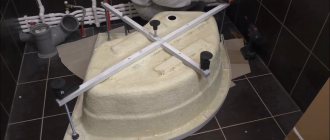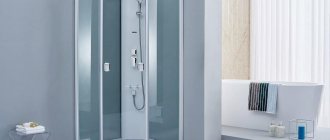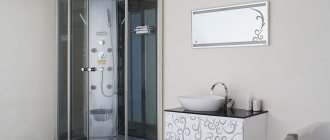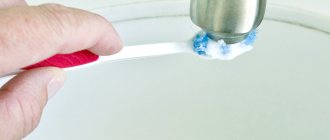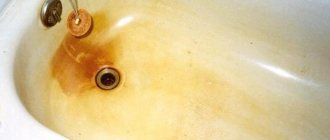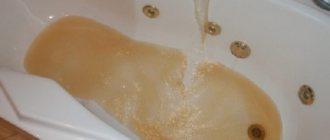- Toothpaste
Shower stalls are becoming increasingly popular due to their compact size and practicality, but they require special care, since high humidity and improper cleaning lead to the formation of various types of contaminants. In this regard, housewives have a reasonable question: how to clean the shower stall from soap stains and limescale?
Shower stalls are compact and easy to use, but are susceptible to various contaminations. Difficulty in maintenance due to the combination of different materials that require the use of several cleaning products and methods
The simple tips presented in the article will help you keep your shower surfaces clean and hygienic.
Frequency of cleaning shower cabins
The shower stall, like any plumbing fixtures, is cleaned regularly. The frequency and intensity of cleaning depends on the number of people living in the apartment, water hardness and quality of detergents.
For effective operation and an attractive appearance, it is necessary to carry out superficial and general cleaning of the cabin.
Regular
Regular cleaning is carried out daily or once every 2-3 days. It prevents the appearance of limescale, which is the main cause of plumbing failure. Deposits form when water and soap come into contact with device elements for a long time, so it is important to clean and wipe surfaces in a timely manner. Cleaning takes no more than 10 minutes.
Regular cleaning of the shower stall.
To clean your shower at home, just rinse the walls, tray and chrome elements with a stream of hot water from the shower, and then wipe them dry with a soft cloth.
Planned
Scheduled cleaning of the shower is carried out once every 2-3 weeks with constant use.
The equipment should also be washed after a long period of inactivity. To carry out general cleaning, use a non-aggressive cleaning agent and additional equipment:
- a cloth that absorbs water well;
- foam sponge;
- rubber scraper;
- an old toothbrush.
Cleaning the shower stall with a rag.
The detergent is applied with a sponge to all accessible surfaces (doors, tray, shower head and shower stand, faucets, drain holes). It is left for the recommended time, after which it is washed off and the shower stall is wiped dry.
Hard-to-reach places and heavy dirt are cleaned with a scraper or toothbrush. If fungus is detected, use antiseptic agents: chlorine bleach, vinegar, soda, laundry soap.
Factors that determine the rate of contamination of plumbing fixtures
During operation, dust settles on plumbing fixtures, deposits and stains from detergents accumulate, and drying drops of water leave traces of salts and rust particles. The faster surfaces become dirty, the more often routine and general cleaning must be done. What determines the speed at which the shower stall becomes dirty?
Supplied water quality
The water supplied to homes through pipelines varies in hardness in different regions. Water becomes hard as it percolates through limestone and chalk deposits and becomes saturated with minerals.
Such water leaves traces in the form of plaque on the walls and shower tray, scale in kettles and water heaters, and clogs small holes in the shower head.
The quality of water is also affected by the pipes through which it is supplied. If they are worn out, a rust-colored liquid with an unpleasant odor enters the apartment. Such water leaves yellowish marks on all surfaces with which it comes into contact, white plumbing is especially affected.
Availability of filters
The negative impact of poor quality water can be mitigated by installing filters. It is optimal to connect several filters at the input that perform coarse and fine cleaning.
Care products used
Plumbing fixtures will get dirty faster if the cleaning products and tools are chosen incorrectly. Abrasives and hard brushes damage the surface, leaving scratches, sometimes even invisible to the eye, in which already noticeable dirt accumulates.
Shower Cleaners
Compositions containing aggressive chemicals and abrasives are not suitable for cleaning the shower stall.
Shower cabin cleaning products.
You should choose gentle products for cleaning acrylic and glass surfaces, for example:
- "Cif cream" Carefully cleans surfaces from soap and lime deposits and rust. It has a soft creamy structure.
- "Unicum" for acrylic surfaces. Removes all types of contaminants (lime deposits, rust, stubborn dirt, fungus). Renews polymer surfaces, forming the thinnest film on them.
- "Sanelit" with anti-mold effect. Cleans glass and plastic surfaces, chrome elements, tiles, glass. Forms a protective film and prevents the formation of fungal plaque.
- "Mr. Muscle" spray. Suitable for cleaning glass or transparent surfaces. No streaks, adds shine.
- "Meine Liebe". An eco-friendly product made from natural fruit acids removes traces of soap, limescale, mold and mildew. It has a pleasant smell and does not emit toxic substances.
Spray Mister Muscle.
You can use other professional products. Each department of household chemicals offers its own range of cleaning compounds. You should choose those that are marked “for acrylic bathtubs and showers.”
How to deal with stains on walls
Even after thorough cleaning, untidy streaks may remain in the shower stall, casting a shadow on the owner’s reputation. The old habit of wiping all polished surfaces with a cloth lets us down, but textiles are not suitable for plastic, glass and ceramic tiles. In addition, a rough cloth, a brush or a brush with stiff bristles can scratch the tray or the walls of the hydrobox and damage the anti-corrosion coating of the steel reinforcement. To keep your shower cabin looking attractive for as long as possible, use non-marking materials and tools to clean the box and remove residual moisture:
- melamine sponge;
- pieces of non-woven latex or microfiber fabric;
- steam cleaners;
- rails and scrapers made of polyurethane, rubber and silicone.
Cleaning the walls of the cabin from limescale
The cabin walls are made of plastic or polystyrene. These materials have a microporous structure and therefore accumulate lime deposits faster than others. Over time, surfaces take on an unpresentable appearance. The difficulty of cleaning lies in the fact that plastic cannot be exposed to aggressive detergents (formaldehyde, chemical acids, alkalis), which are often used to remove complex contaminants.
Cleaning the walls of the shower cabin.
It is recommended to use gentle industrial compounds intended for cleaning shower stalls, or folk remedies:
- soda;
- vinegar;
- citric acid;
- ammonia;
- hydrogen peroxide.
The selected product is applied with a soft sponge to a clean, damp surface, left for 10-30 minutes, and then rinsed with warm water. To remove complex contaminants, use a rubber or silicone scraper.
How to remove plaque from glass
To clean glass, it is recommended to use ready-made liquid products, preferably in the form of sprays.
This way they are better applied and evenly distributed over the surface.
Cleaning the walls of the shower stall.
An ammonia (ammonia) solution, which is prepared from the following components, will help to clean the cabin doors from soap stains and add shine:
- ammonia - 25 ml (1 tbsp);
- water at room temperature - 1 l.
Moisten a microfiber cloth in the product and wipe the glass surfaces until there are no streaks left on them. Ammonia has a pungent odor, so treatment should be carried out with the bathroom doors open.
How to clean metal fittings?
Metal fittings and shower components also require periodic cleaning and anti-corrosion treatment. Steel faucets, hoses, shower heads, brackets and door hinges are often coated with plaque, but if the steel has a nickel-chrome coating, you cannot scrape the shower equipment with abrasives, otherwise you will damage the integrity of the coating and leave the fittings vulnerable to corrosion.
The decorative film of a tinted aluminum profile is also easily damaged by rough mechanical action, and unsightly areas of exposed metal are revealed under the layer of peeling paint. Chrome-nickel steel and painted aluminum are treated in the same way as plastic and tempered glass - carefully wiped with a sponge or microfiber cloth moistened with gel or liquid SMS for shower cabins. Special compounds for chromium-nickel steel are also produced, for example, Frosh.
Professional cosmetics for hydroboxes and metal fittings are too expensive to rely solely on them. For proper care of shower stalls, thrifty owners try to select effective combinations of commercial and folk remedies that extend the service life of the box to 10 years or more. Surround the shower with care - and it will become the coziest corner of the bathroom!
Cleaning the tray
There are several ways to wash the tray. The choice of the optimal cleaning option depends on the material from which the plumbing fixture is made.
Cleaning the shower tray.
Made from acrylic
Acrylic repels dirt well, so it is easy to care for. However, acrylic surfaces can only be cleaned with professional means. Abrasive, alcohol-containing, powdery compounds are not suitable for cleaning acrylic trays as they leave scratches and stains.
Cleaning an acrylic shower tray.
Among folk remedies, it is allowed to use laundry soap or toothpaste without abrasive particles. The selected product is applied to the acrylic surface with a soft sponge, left to act for 10-15 minutes, then washed off with warm water.
From stone
Natural stone is a beautiful and durable material that retains its aesthetic properties throughout the entire period of use. The stone tray requires minimal maintenance, which consists of wiping it with a clean damp cloth. The resulting limescale deposits are removed with a steam cleaner and a soft cloth.
Cleaning a stone tray in the bathroom.
A tray made of artificial stone tends to darken or change color over time. It can be washed with soft creamy or foaming products.
You cannot use vinegar, alkaline compounds, solvents, or degreasers, as this can lead to cracking or discoloration of the surface.
Enameled tray
Over time, limescale and rust appear on enameled plumbing fixtures. During water procedures, dirt, sweat and sebum flow down the surface, forming a fatty film.
Cleaning the shower tray.
To remove persistent stains from enamel, it is permissible to use abrasive agents (Pemolux or Comet), as well as chlorine-containing compounds. They are applied to the surface, lightly rubbing, for 10-15 minutes, and then washed off with hot water. Do not use products based on chemical acids, alkali, or formaldehyde.
Mold Removal
Fungus grows in the shower stall due to dampness and poor ventilation. Remove mold stains with chlorine-containing compounds, vinegar, alcohol or soda.
The product should be selected taking into account the type of surface.
The reasons for the appearance of fungus in the shower stall are constant dampness.
To remove foci of mold, an antiseptic composition is applied to the stain, left for 30-40 minutes, the dirt is removed with a sponge, and washed off with hot water. It is better to clean hard-to-reach places with a toothbrush.
To prevent the fungus from growing again, it is recommended to wipe the cabin dry after use and regularly ventilate the bathroom.
Prevention
With the help of preventive measures, you can avoid many problems associated with dirty showers. For example, ventilation, airing and wiping the walls dry after a shower will help prevent the appearance and development of fungi and mold, which prefer excess moisture.
Using Melamine Sponge
The good thing about a melamine sponge is that when using it, you don’t need to apply and rinse off cleaning solutions. According to the principle of operation, it is similar to an eraser, only it erases not traces of a graphite pencil, but dirt.
Melamine sponge.
Use the sponge as follows:
- one edge of the sponge is moistened with water;
- remove dirt using circular movements;
- The cleaned surface is rinsed with warm water.
A melamine sponge can be used to remove lime and grease deposits, soap stains, and rust stains on plastic, enameled and chrome surfaces. It is not recommended to use items to clean trays made of glossy artificial stone and acrylic.
Folk remedies
Folk remedies for cleaning and disinfecting surfaces are less toxic than their industrial counterparts. They effectively cope with dirt, remove fungal spores and other harmful microorganisms.
However, you should be careful when choosing a detergent composition: the acids contained in some products can damage the elements of the shower cabin. Before applying the solution to the surface, it should be tested on an inconspicuous area. If its structure remains the same, the product can be used over the entire area.
Folk remedies for shower cleaning.
Lemon solution
Citric acid dissolves lime and soap deposits well, and also destroys unpleasant odors.
The product can be used to clean enameled and chrome-plated plumbing fixtures. For cleaning, prepare a working solution from 1 tbsp. l. powder and 1 cup hot water.
A foam sponge is moistened in the mixture and the contaminated areas are wiped with it. For better effect, leave the composition for 20-30 minutes, then rinse with water.
Toothpaste
Toothpaste (without abrasive particles) effectively removes any dirt and polishes surfaces, sealing shallow scratches. It can be used for chrome, glass, enamel and acrylic plumbing elements.
Using toothpaste.
Apply the paste with a wrung out damp cloth or sponge. If dirt or stains are not washed off immediately, leave the product to act for several minutes. After use, surfaces are rinsed with water and wiped dry.
Soda and peroxide
A mixture of soda and hydrogen peroxide removes grease and soap deposits well, removes fungal spores, and disinfects plumbing fixtures. It is used to clean enameled, chrome, and stone elements of the cabin. It is not recommended to use baking soda on glass and acrylic as it may leave scratches.
Cleaning with soda solution.
To prepare the working solution, acid powder and hydrogen peroxide are mixed in a 1:1 ratio. Use a sponge soaked in the composition to wipe off stains and dirt, then rinse off the product with water. To remove stubborn stains, leave the solution for 10 minutes.
Vinegar
Vinegar dissolves grease, lime, rust, and also effectively removes mold. For cleaning, prepare a solution consisting of 1 part 9% table vinegar and 2 glasses of water. For ease of application, the liquid is poured into a spray bottle. You can also add a few drops of essential oil with disinfectant properties:
- tea tree;
- eucalyptus;
- cedar;
- lavender;
- carnations.
Using vinegar.
The product is used to treat plastic, glass and enamel surfaces, then wipe them with a sponge and rinse with water.
Cleaning plastic surfaces
To clean the plastic from which the walls and doors of the shower stall are made, you should carefully consider the choice of product. It should not contain aggressive acids, alkalis, alcohols or formaldehyde. You should not use abrasives; it is better to give preference to cleaning creams and aerosols. Before using the product, try it on an inconspicuous area. It is recommended to wash the plastic as often as possible, and wash off the soap scum after each use. If this is not done, the plastic will inevitably darken.
Plastic is a fairly unstable material, so use sponges and soft-surfaced cloths to clean it.
Advice! Dishwashing detergents are effective in combating soap scum and dirt.
Basic rules for caring for a shower stall
The main problem that causes most of the breakdowns of shower cabins is poor quality water coming from the water supply. Salts and impurities settle on the walls of mixers and hydromassage nozzles, causing them to fail prematurely. To prevent damage, it is recommended to install filters before each water entry into the plumbing fixture. Filters need to be replaced once every 2-3 months.
Caring for cabin walls.
Dirt on the walls and doors of the cabin should be removed at least once a week. To prevent the accumulation of soap and limescale deposits, surfaces must be rinsed and wiped dry every time after taking a shower.
To prevent the formation of fungus in places where water accumulates, it is recommended to install a forced ventilation system in the bathroom (exhaust fans installed on the vent). If this is not possible, the bathroom door should be kept ajar to allow air circulation inside the room.
